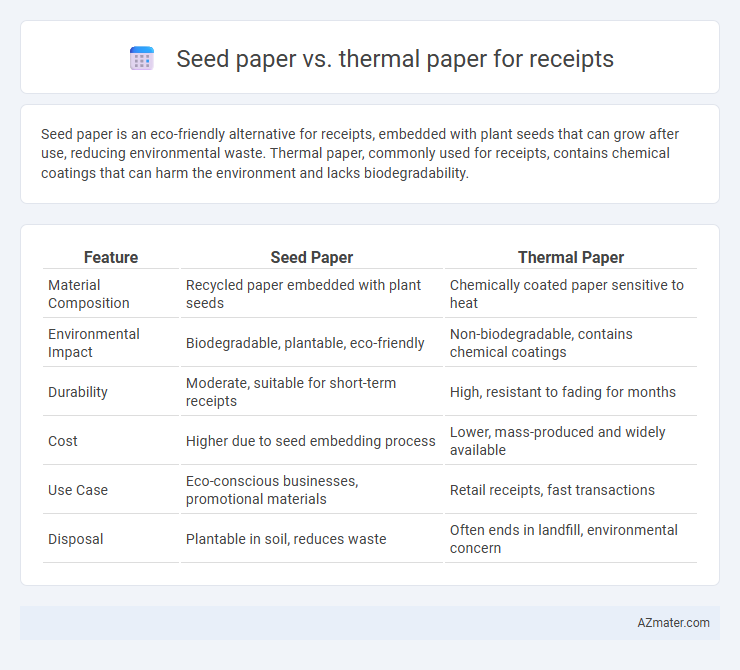Seed paper is an eco-friendly alternative for receipts, embedded with plant seeds that can grow after use, reducing environmental waste. Thermal paper, commonly used for receipts, contains chemical coatings that can harm the environment and lacks biodegradability.
Table of Comparison
| Feature | Seed Paper | Thermal Paper |
|---|---|---|
| Material Composition | Recycled paper embedded with plant seeds | Chemically coated paper sensitive to heat |
| Environmental Impact | Biodegradable, plantable, eco-friendly | Non-biodegradable, contains chemical coatings |
| Durability | Moderate, suitable for short-term receipts | High, resistant to fading for months |
| Cost | Higher due to seed embedding process | Lower, mass-produced and widely available |
| Use Case | Eco-conscious businesses, promotional materials | Retail receipts, fast transactions |
| Disposal | Plantable in soil, reduces waste | Often ends in landfill, environmental concern |
Introduction to Receipt Paper Types
Receipt paper types primarily include seed paper and thermal paper, each with unique characteristics suited for different uses. Seed paper is eco-friendly, embedded with plant seeds that can be planted after use, promoting sustainability in business practices. Thermal paper offers quick, high-quality printing via heat-sensitive technology, widely adopted in retail for its efficiency and cost-effectiveness.
What is Seed Paper?
Seed paper is an eco-friendly type of paper embedded with seeds that can be planted after use, promoting sustainability and reducing waste typically associated with receipts. Unlike thermal paper, which relies on heat-sensitive chemicals and often contains BPA or BPS, seed paper offers a biodegradable alternative that supports environmental conservation. This innovative paper not only functions as a receipt medium but also encourages consumers to grow plants, aligning with green business practices.
What is Thermal Paper?
Thermal paper is a special fine paper coated with a chemical that changes color when exposed to heat, commonly used in receipt printers to produce fast, clear text without the need for ink. It provides sharp image quality and is widely adopted in retail environments for its efficiency and cost-effectiveness. Despite its convenience, thermal paper can fade over time and contains BPA or BPS chemicals, raising environmental and health concerns compared to alternatives like seed paper.
Environmental Impact: Seed Paper vs Thermal Paper
Seed paper, embedded with biodegradable seeds, decomposes naturally and promotes plant growth, significantly reducing waste and carbon footprint compared to thermal paper, which contains toxic chemicals like BPA and BPS that pose environmental hazards during disposal. Thermal paper is generally non-recyclable due to its chemical coating, contributing to landfill accumulation and potential soil and water pollution. Seed paper's compostable nature and positive ecological benefits make it a more sustainable choice for receipt printing in terms of environmental impact.
Biodegradability and Sustainability
Seed paper outperforms thermal paper in biodegradability, as it is embedded with plant seeds that decompose naturally and promote environmental regeneration when planted. Thermal paper often contains BPA or BPS chemicals, hindering its recyclability and contributing to ecological pollution. Choosing seed paper receipts significantly enhances sustainability by reducing toxic waste and supporting circular economy practices.
Cost Comparison and Production
Seed paper for receipts involves higher production costs due to embedded biodegradable seeds and eco-friendly materials, making it pricier than traditional thermal paper. Thermal paper is mass-produced using chemical coatings for heat sensitivity, resulting in lower manufacturing expenses and cheaper end-product prices. Cost comparison reveals that seed paper offers sustainable advantages at a premium, while thermal paper remains the most economical choice for high-volume receipt printing.
Printing Process: Seed Paper vs Thermal Paper
Seed paper printing relies on traditional inkjet or laser printers, requiring specialty inks that do not harm the embedded seeds, ensuring seed viability after use. Thermal paper uses a heat-sensitive coating that reacts to thermal printer heads, producing images without ink but is sensitive to heat, light, and chemicals, potentially affecting longevity. The printing process for seed paper emphasizes eco-friendly, non-toxic methods compatible with plantable materials, while thermal paper prioritizes speed and efficiency in high-volume receipt printing.
Health and Safety Concerns
Seed paper for receipts is an eco-friendly alternative that eliminates harmful chemicals commonly found in thermal paper, such as bisphenol A (BPA) and bisphenol S (BPS), which pose health risks including endocrine disruption. Thermal paper receipts often contain these toxic substances that can transfer to skin and cause allergic reactions or long-term health problems upon frequent contact. Choosing seed paper reduces exposure to hazardous chemicals while promoting sustainability and safe disposal through biodegradability and plant growth.
User Experience and Practicality
Seed paper receipts enhance user experience by offering an eco-friendly alternative that can be planted to grow plants, reducing waste and promoting sustainability. Thermal paper receipts provide practical benefits through fast printing and high-quality, smudge-resistant images, although they often contain BPA or BPS chemicals, raising health and environmental concerns. Choosing seed paper prioritizes environmental impact and user engagement, while thermal paper focuses on convenience and cost-effectiveness for businesses.
Future of Eco-Friendly Receipts
Seed paper receipts integrate biodegradable materials embedded with plant seeds, promoting sustainability by encouraging planting after use, whereas thermal paper relies on chemical coatings that contribute to environmental waste. The future of eco-friendly receipts is shifting towards seed paper as businesses adopt green initiatives to reduce carbon footprints and enhance recycling efforts. Innovations in seed paper technology aim to improve durability and cost-efficiency, positioning it as a viable replacement for traditional thermal receipts in retail and hospitality sectors.

Infographic: Seed paper vs Thermal paper for Receipt
 azmater.com
azmater.com